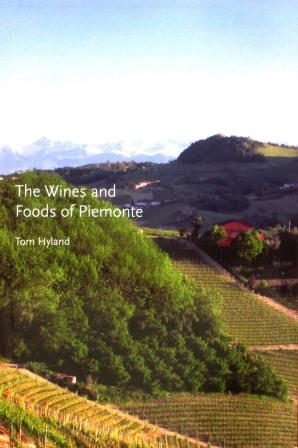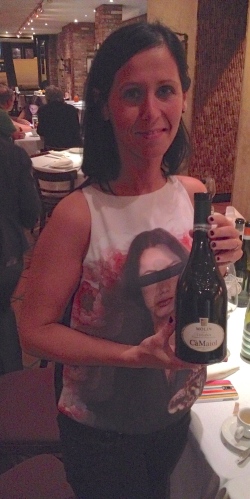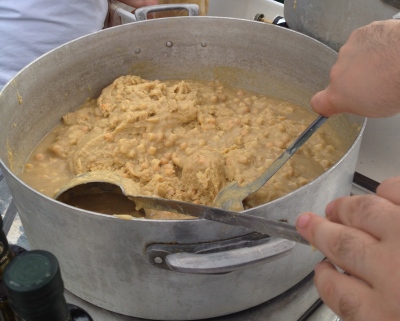I have tasted the wines of CasaSetaro in the U.S and in Italy and really liked them.

Massimo Setaro
Michele and I were spending 3 weeks in Rome when I received an e-mail from Massimo Setaro (the winery is in the Vesuvius National Park) that he wanted to come to Rome so I could taste his wines.
We met at Bar del Fico, Piazza del Fico 26, for a light lunch so that I could taste the wine with food. It is close to the apartment we rented and we go there for our morning café, drinks, and to eat. It a kind of funky place and the people are very nice.
Massimo said the winery is located on the slopes of Mt. Vesuvius in Trecase. All the vineyards are located inside the Vesuvius National Park.
There are 4,500 plants per hectare. He spoke about the terroir and said it is volcanic and sandy with a layer of lava on the surface and volcanic stone. There is a mineral character present in the wines. This composition of the soil makes the vines immune to phyloxera so many of the plants have European roots.
The exposure of the vineyards are south, southeast, at 200 to 450 meters. If you walk to the highest point, you would be surrounded by the forests of the Vesuvius National Park. Green organic manure is used and the vines are treated only with copper and sulfur. Selected yeast is used in all the wines and the winery uses only their own grapes.
Massimo said he had bought a number of oak barriques but does not use them for wine anymore. Now they are used for planters.
Massimo said he learned a lot from his father growing up in the winery where they live. He said he takes care of all the production steps from vineyard management to the final bottling and his wife, Mariarosaria, works at his side.
I was very impressed with the passion in his voice when he spoke about growing up in the winery, the Vesuvius National Park, his wines and that he and his family live at the winery.
The Wines
Caprettone Spumante Method Classico 100% Caprettone Production zone Alto Tirone, Vesuvius National Park. The age of the vineyards is 18 to 25 years. They are at 350 meters and the training system is espalier, guyot trained with a few buds per plant. Vinification: maceration at 4C in steel tanks, fermentation for 18 to 24 days, the second fermentation takes place after about six months. The wine remains on the lees for 30 months and remains in bottle for about 12 months before release.
In June when I was a judge at Radici del Sud in Puglia, this wine was picked as # 1 in the spumante category by the journalist panel of which I was a member.
Massino said the Caprettone grape is excellent for making spumante method classico because it has very good body and produces a round and elegant wine. I have to agree.
Falanghina Campania IGT “Campanelle” 100% Falanghina del Vesuvio. Production Area: various micro zones within the Vesuvius National Park. The vineyards are at 250 meters and the vines are 18 years old. The training system is espalier with guyot pruning.
Massimo feels that Falanghina does not have the same rich character as the Caprettone. We both agreed however that with spaghetti con vongole verace, spaghetti with clams, we would drink the Falanghina. The wine has nice citrus aromas and flavors with a touch of minerality.
Lacryma Christi del Vesuvio DOC Bianco “Munazei” 100% Caprettone. Production zone Vesuvius National Park. The training system is Vesuvian pergola and guyot. Vinification: Maceration in steel tanks at a controlled temperature and fermentation lasts for about 20 days. The wine remains in steel tanks for about 6 months and then in bottle for two months before release.
Michele and I first had wines made from the Caprettone grape few years ago on the Amalfi Coast and have been drinking them ever since.
Munazei- this is what they called the cold storage rooms built into the mountain where food was kept to prevent spoilage.
Lacryma Christi del Vesuvio DOC Rosato “Munazei” 100% Piedirosso. The vineyards are at 300 to 350 meters and the vines are 20 years old. Training system is espalier, guyot and Vesuvian pergola. There is a soft destemming and pressing followed by low temperature skin fermentation in stainless steel tanks at 4C for about 24 hours. The lees are removed and there is cleaning and controlled temperature fermentation at 10 to 12C for 18 to 24 days. The wine remains in steel tanks for 3 months and another 2 months in bottle before it is released. It has aromas and flavors of fresh red fruit with hints of cherry, strawberry and raspberry.
Lacryma Christi del Vesuvio Piedirosso DOC 100% Piedirosso. Espalier, guyot training Vesuvian pergola. Vinification: Maturation in stainless steel tanks for 6 months and in bottle for 3 months before release. The wine has hints of dark fruit with touch of blackberries violets. It is an easy drinking wine that goes very well with food.
Lacryma Christi del Vesuvio Rosso DOC Riserva “Don Vincenzo” Made from 85% Piedirosso and 15% Aglianico. The production area is Tirone della Guardia. The vineyards are at 350 meters and are 30 years old. The training system is espalier, guyot trained. There is a natural selection of the hand picked grapes. Fermentation takes place, with skin contact for 12 to 14 days. The wine is then aged for 24 months in French oak tonneau and in bottle for 6 months before release. This is a deeply rich wine with hints of cherries and raspberries with a long finish and pleasing aftertaste. Massimo said this wine is named after his father. He is very proud of the wine and gave me a magnum as a gift!
 Back during the summer, my colleague and friend Tom Hyland published an important and useful new book, The Wines and Foods of Piemonte. It covers just about everything a wine lover could want to know about this blessed region, but of course – since the subject is the Piedmont – it gives pride of place to red wines. For that reason, I thought I’d wait to say anything about it until the weather cooled down, and an oenophile’s fancy lightly turns to vino rosso.
Back during the summer, my colleague and friend Tom Hyland published an important and useful new book, The Wines and Foods of Piemonte. It covers just about everything a wine lover could want to know about this blessed region, but of course – since the subject is the Piedmont – it gives pride of place to red wines. For that reason, I thought I’d wait to say anything about it until the weather cooled down, and an oenophile’s fancy lightly turns to vino rosso.














































